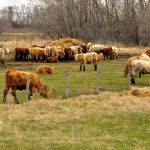
Tag Archives Infection
Beef 911: Ways to reduce incidence of navel ill
You need to pay close attention to this costly problem and take steps to reduce it

Antimicrobial use in beef to meet new pressures
Antimicrobial resistance in the Canadian beef sector is currently low, but experts warn that producers should be cautious of overuse

Antimicrobial resistance in cattle means big changes coming
An alarming rise in resistance even has drug companies calling for producers to change their ways

It’s prime time for anthrax, so keep a close eye on your cattle
Highly contagious, infectious soil-borne disease finds victims in grazing livestock

Vesicular stomatitis: A travel advisory
Horse Health: The rules have changed for transporting horses across Canada-U.S. border

Beef 911: Cattlemen can ensure biosecurity on the ranch
Maintaining a few simple precautions can minimize the risk of disease outbreaks

Canadian case of PED virus provided link for researchers
Biosecurity measures are still key, but preventing the contamination of feed will help slow the spread of PED

Beef 911: Kidney disease in cattle more common than realized
If symptoms are noticed early enough, treatment can be effective
Manitoba PEDv case not linked to feed: CVO
There are 24 farms affected in Eastern Canada

Strawberry foot rot is on the increase in feedlots
An infection previously mostly found in dairy cattle is showing up in some western feedlots


